Stairwell (2010 DOWNIE ESHKAR KAISER)
Stairwell, a site-specific 3D installation for London’s Hayward Gallery, is a collaboration with dancer/choreographer Wayne McGregor, whom we captured dancing in the same stairway that viewers now enter to see the piece. The imagery floats in three 3D projections that are stacked vertically on a wall closely opposite the circular stairs.
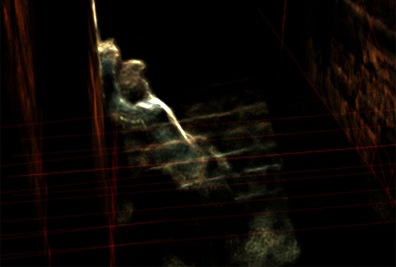
In Stairwell, we plunge our viewers into a complex perceptual realm where they can experience the dancing of British choreographer Wayne McGregor as never encountered before. With the 3D imagery of the work floating in space as if within their hand’s reach, their eyes seem almost to touch the contours of McGregor’s motions. These motions, they soon recognize, were performed on the same gallery stairs on which they now find themselves; and they then realize that it’s his continual re-orientation to the odder angles and corners of that stairwell that constitute his dance.
Our 3D capture of McGregor is itself oddly elusive, with the imagery always striving – but often failing – to cast his figure as a solid sculptural form for each instant of his movement. There’s a perceptual battle to tell figure from ground, for a curvature of the architecture is easily mistaken for that of a limb, the angle of a knee or elbow for that of a stair. In the ongoing effort to reconstruct three-dimensional forms, surfaces lurch towards and away from solidity in the most startling fashion, and it’s only through its movement that the dancing body separates itself from its fixed surrounding, lifting into clear articulation before subsiding into the visual flux again.
When the opportunity arose to make Stairwell at the Hayward, we all took a faster, riskier, improvisatory approach to the piece than either we or McGregor normally take. On our side, we’d just devised a new device for 3D capture to allow us to do fieldwork, so to speak, rather than confining ourselves as usual to a motion-capture studio. Thus we could use the site of the Hayward stairwell itself as our stage, and we deployed the full system there for the first time one evening in July.
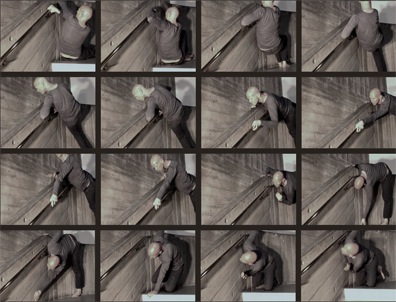
Meanwhile, we’d prevailed upon McGregor to perform the new dance himself rather than directing one of his dancers. We’d found from our previous work with Merce Cunningham, Trisha Brown, and Bill T. Jones that the signature motion of a choreographer has its own secrets to tell, so McGregor’s enthusiastic assent was a big step forward. It meant that when the time came we could all move forward fast. Literally so in McGregor’s case, for his movements kept accelerating to speeds that challenged our ability to capture them. He did take his time, however, in shaping his dancing to the eccentric spaces he was discovering on the stairs. As he did so, we kept finding new ways to frame that moving body in space from the re-orienting angles that would give rise to the final 3D compositions we rendered for the finished piece.
McGregor’s intuitions about the space were made visible to us (and our cameras) through the movements of his thinking body. And after each improvisation, he was able to see our visual thinking in the take we would immediately play back for him. His response to our response led him to his next move, and then his to ours, forming the back-and-forth exchange that ended up generating Stairwell.
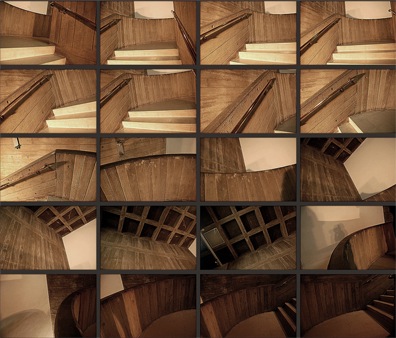
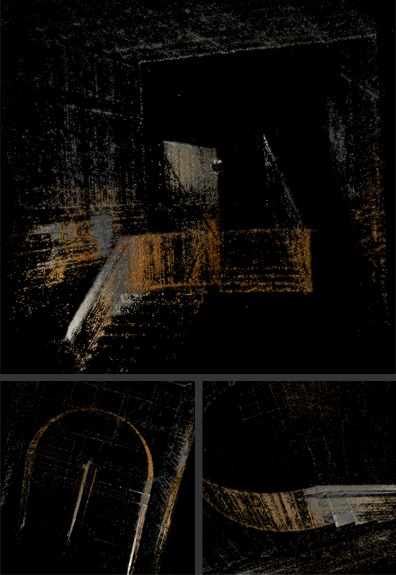
We captured the space of the stairwell by spatializing 300 or so still photos of it. This allowed us to place the motion files within the larger architectural space, which we could also view in 3D and from angles unrepresented in either the video or stills capture process.
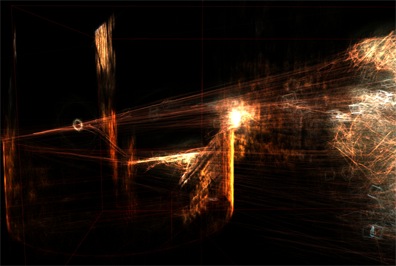
Furthermore, we could even have our virtual camera diverge from these algorithmically derived angles, so that the viewer could be looking at looking. This tendency is pushed to an extreme in the most abstract views, to be found on the lowest of the three stacked projections.